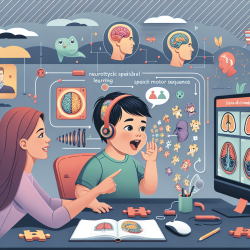Empowering Speech: Unlocking Potential Through Data-Driven Insights
In the realm of speech-language pathology, harnessing the power of data-driven insights can transform therapeutic outcomes, particularly for children facing speech challenges such as stuttering. A recent study titled Behavioral and Neural Correlates of Speech Motor Sequence Learning in Stuttering and Neurotypical Speakers: An fMRI Investigation provides invaluable insights into the neural mechanisms underlying speech motor sequence learning, offering practitioners actionable strategies to enhance therapy effectiveness.
Understanding the Research
The study delves into the intricacies of speech motor sequence learning by comparing adults who stutter (AWS) with neurotypical speakers (ANS). Utilizing functional magnetic resonance imaging (fMRI), researchers examined brain activity during the articulation of novel and practiced pseudowords. The findings reveal that while both AWS and ANS exhibit similar learning trajectories, AWS face challenges in executing speech motor sequences before and after practice.
Key Findings and Implications
The research highlights several critical findings:
- Both AWS and ANS show comparable increases in activation in left-lateralized brain areas involved in phonological working memory and speech motor planning during novel sequence production.
- Despite similar learning capabilities, AWS exhibit impaired execution of speech motor sequences, indicating a need for targeted interventions to enhance motor execution skills.
- Activation in left-lateralized basal ganglia sites correlates negatively with disfluency in AWS, suggesting potential therapeutic targets for improving fluency.
Applying Insights to Practice
For practitioners at TinyEYE and beyond, these findings offer a roadmap for refining therapeutic approaches:
- Focus on Motor Execution: Develop interventions that specifically target the execution phase of speech motor sequences, incorporating repetitive practice and feedback mechanisms to enhance motor skills.
- Utilize Neuroimaging Insights: Consider integrating neuroimaging data to tailor interventions based on individual neural activation patterns, optimizing therapy for each child's unique needs.
- Encourage Further Research: Practitioners are encouraged to explore additional research opportunities to deepen understanding of the neural underpinnings of stuttering and refine therapeutic strategies.
Conclusion
The study underscores the importance of data-driven decision-making in speech therapy, providing a foundation for developing targeted interventions that address the specific challenges faced by children who stutter. By leveraging these insights, practitioners can enhance therapeutic outcomes, empowering children to achieve their full communicative potential.
To read the original research paper, please follow this link: Behavioral and Neural Correlates of Speech Motor Sequence Learning in Stuttering and Neurotypical Speakers: An fMRI Investigation.










